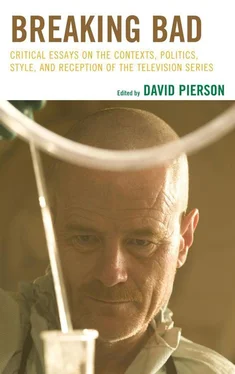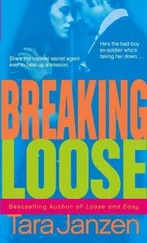Gretchen’s comment occurs in the episode “Gray Matter” (2/24/08).
Walt makes this declarative statement in the episode “Crazy Handful of Nothin” (3/28/08).
This flashback occurs in the episode “…And the Bag’s in the River” (2/8/08).
A narcocorrido is a Mexican ballad centered on the exploits of drug traffickers in Mexico.
Gus demonstrates to Walt and Jesse his penchant for cold-blooded murder in the episode “Box Cutter” (7/17/11).
This image occurs in the episode “Caballo sin Nombre” (3/28/10).
If we suppose that the diegetic time concurs with the year of broadcasting (2008).
Please see http://www.nobelprize.org/nobel_prizes/chemistry/laureates/1985/.
Please see http://www.nobelprize.org/nobel_prizes/physics/laureates/1985/.
In Max Weber’s theory of action instrumental rationality ( Zweckrationalität ) is opposed to value-oriented rationality ( Wertrationalität ), emotional or affective action ( Affektuel ) and traditional action ( Traditionell ) (Weber 1978). See Brubaker 1984.
The fifth season’s strong shift in White’s characterization does not cancel the interpretation that can be made of the first four seasons. An analysis of a TV series that spreads along six years can legitimately take as its corpus the whole series, one single season or even one or more single episodes.
Please see http://www.nobelprize.org/nobel_prizes/physics/laureates/1932/index.html.
See Cassidy 2009. For a synthesis of the different interpretations of Heisenberg’s contribution to Nazi research see Landsman 2002. This topic is also the subject of Michael Frayn’s successful play Copenhagen (1998).
I have regularly visited http://blogs.amctv.com/breaking-bad, http://www.imdb.com/title/tt093747and http://www.tv.com/shows/breaking-bad.
Please see http://blogs.amctv.com/breakign-bad/2012/07/episode-1-story-sync-poll-results.php. Final poll results.
See Christian Metz’s (1982) classic theory, that distinguishes between primary identification (with the camera) and secondary identification (with a character). The sympathy for Walter is also induced by Bryan Cranston’s previous comic roles in the sitcoms Seinfeld (created by Larry David and Jerry Seinfeld, NBC, 1989-1998) and Malcolm in the Middle (created by Linwood Boomer, Fox, 2000-2006).
“If we must blame anyone for the curse of relativism that supposedly afflicts modern thought (no one’s story is ‘privileged’, as the sociologists like to say, above anyone else’s; all viewpoints are equally valid), then probably we should blame Heisenberg more than Einstein. Relativity—the scientific theory of space-time, that is—indeed says that different observers will see events in different ways, but it also offers a framework by which these different viewpoints can be reconciled to a consistent and objective account. Relativity doesn’t deny that there are absolute facts; that’s what the uncertainty principle does” (Lindley 2008, 213).
I tried to map the presence of science in contemporary serials in Brodesco 2013.
Created by Matt Groening, Fox, 1999-.
Created by Chuck Lorre and Bill Prady, CBS, 2007-.
Created by Nicolas Falacci and Cheryl Heuton, CBS, 2005-2010.
Created by Mark Frost and David Lynch, ABC, 1990-1991.
Created by Alan Ball, HBO, 2001-2005.
Created by Brannon Braga, David S. Goyer and Robert J. Sawyer, ABC, 2009-2010.
Created by Andrew Cosby and Jaime Paglia Eureka, SyFy, 2006-2012.
Created by Jeffrey Lieber, J. J. Abrams and Damon Lindelof, ABC, 2006-2010.
Created by Jason Horwitch, AMC, 2010.
A genre recently elaborated within the field of Film Studies is the “mind game film,” a movie—from The Sixth Sense (M. Night Shyamalan, 1999) to Inception (Christopher Nolan, 2010)—that inquires and defies audience’s understanding, progressively unsettling and withdrawing the information and knowledge that text had delivered (see Elsaesser 2009).
Created by J. J. Abrams, Roberto Orci and Alex Kurtzman, Fox, 2008-2013.
Created by Elizabeth Sarnoff, Steven Lilien, Bryan Wynbrandt, Fox, 2012.
Created by René Echevarria and Scott Peter, USA Network, 2004-2007.
Created by Joss Whedon, Fox, 2009-2010.
Read this extract from a 2011 interview where Vincent Gilligan declares: “Film noir is a big influence: the classic noirs—I could watch The Maltese Falcon once a month, probably—as well as the Coen brothers contemporary ones as well” ( http://blogs.amctv.com/breaking-bad/2011/10/vince-gilligan-interview.php).
The date of release of A Serious Man , September 2009, is six months earlier than the broadcast of season three.
See David Lavery’s online essay, “Bad Quality: Breaking Bad as Basic Cable Quality TV” Critical Studies in Television . http://www.criticalstudiesintelevision.com/index.php?siid=13805.
See Martin Miller’s interview “The End Nears for Walter White of Breaking Bad” Los Angeles Times Sept. 1, 2012. http://www.latimes.com/entertainment/tv/showtracker/la-et-st-breaking-bad-vince-gilligan-20120901,0,0854913.storyfor a discussion of the show’s initial development and the importance of the idea of Walt’s character transformation from a mild mannered family into a cold blooded, ruthless killer.
Terminologies can be difficult to utilize with precision, particularly as a wide range of variable usage exists. For instance, both “Latino” and “Hispanic” are used to denote those of Latin American origin, although people from Spain can also be implicated with these terms. Although “Tejano” is usually specific to Mexican-Americans living in Texas, it is occasionally used to denote Texans originating from other Latin American countries. The same is true for “Chicano,” although this term sometimes denotes Mexican-Americans living only in California, and sometimes across the border states. The common denominator with this term is that the individual has an identity stake with at least two geopolitical entities. In The Chicano-Studies Reader , Fernando Peñalosa (2010) notes the multiple factors—cultural, political, ethnic, and biological—that inform such discussion (16-27). As this essay is a character study, and the characters analyzed derive from a variety of backgrounds, no singular term will be employed. However, in service of consistency when discussing the series’ overall project of portrayal, the term “Latino” will be employed, as it most precisely indicates a general background shared by the various characters, nearly all of whom are male.
Читать дальше












